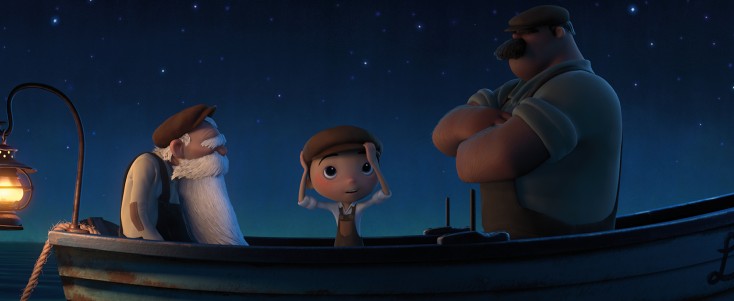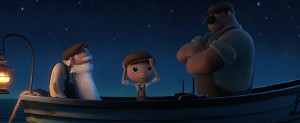By ANGELA DAWSON
Front Row Features
EMERYVILLE, CALIF.—Audiences for Pixar’s new animated feature “Brave,” will be in for an extra special treat. Just before the movie stars, they will get a chance to see a short film called “La Luna,” (the moon) written and directed by Enrico Casarosa, a talented storyboard artist at Pixar Studios.
The animated short tells the tale of a little boy who joins his father and grandfather for work one night out on the ocean. Under a full moon, it becomes clear what this unlikely trio is up to. The sweet, funny animated short already is receiving accolades. It was one of the five short animated films nominated for an Oscar earlier this year.
Casarosa, who also is a comic book artist, illustrator and photographer, is over the moon that his short will have an opportunity to be seen by a wide and diverse audience.
Front Row Features: Is “La Luna” based on your own experience?
Enrico Casarosa: Yes, a little bit. My dad and grandfather never got along very well. We lived in the same house from the time I was 11 until I moved away. I thought that family dynamic would be interesting to explore in a short film. I liked the idea of someone being stuck between two people that don’t get along. It’s a good core to tell in a story about growing up and finding your own way in life. I thought about that personal experience.
Front Row Features: How long did it take to make, from conception to completion?
Casarosa: For the shorts, sometimes we have to wait for the right time to produce them. The total production time was nine months. I had pitched the idea earlier. For a little bit, I was storyboarding it myself but then I was waiting for a team to do it. We have to stay away from the busy time when they’re making (feature-length) movies. It’s an interesting challenge to make a short. Staffing is a challenge. But it’s also interesting because everybody has to do a little more, and you have a small team. You feel tighter and there’s more camaraderie because you have a small team. You move a little faster.
Front Row Features: Whom did you pitch the story to?
Casarosa: I pitched to (Disney/Pixar chief creative officer) John Lasseter, (Walt Disney Animation president) Ed Catmull and (Pixar general manager) Jim Morris. What we try to do is get everyone’s feedback separately. John is the executive producer and he’s a wonderful force who guides and mentors you.
Front Row Features: Did they make suggestions?
Casarosa: John said he thought it should be the boy’s first day on the job. I had just planned to make it just a regular day, but by making it the first day, it puts us in the shoes of the little boy. Like the audience, we’re going to discover what the two men do out at sea. A lot didn’t change, though. We were blessed with a story that had structure. I always had this idea at the end you would realize what they’re doing. It was more about tightening some of the physics of it. We found a contrast between the push broom and the dust broom, which is more about precision.
Front Row Features: How did you develop the story?
Casarosa: I started out with watercolors. I made beat boards. I had 20 images to tell a story. That’s how I pitched it to John Lasseter. I scanned them on a projector. Because the story was so fable-like, I thought the colors would support something a little more like a kid’s book. We scanned pastels for our backdrops.
Front Row Features: You have some great sounds on this. Was it easy to come up with the sounds of the stars?
Casarosa: We had a wonderful sound designer, Justin Pearson. I thought that’s the way the dad and grandfather would experience them. So we looked for something pebbly, tiles or a tiny bit of broken glass. We didn’t want something magical until the end. We thought we’d use sparkly magic sounds when the boy experiences them. We find it in the musical idea of the stars. If you touch them you get a note. That and the big star sound took a while to find. We had a prayer bowl from India. That’s where we were able to build the sound. It was a new thing for me to do because I’m a storyboard artist. Mixing the images and the sound was a lot of fun.
Front Row Features: Where did the idea of the stars on the moon come from?
Casarosa: From the start, I thought it would be fun that the three characters would be sweepers. I wanted to have them doing something mundane. My first few drawings had telescopes. But mostly I was interested in them being janitors in the movie. Then, I had to figure out what would they be sweeping. We then added the moon and the shooting stars. The idea mostly came from the sweeping because we had to have them sweeping something.
Front Row Features: Why the moon?
Casarosa: I’ve always been fascinated by childish explanations of scientific things. There was a wonderful short from the Wallace & Gromit series called “A Grand Day Out,” where they go to the moon and bring crackers and cheese because the moon is made of cheese.
Front Row Features: What’s next for you?
Casarosa: Right now I’m head of story on a movie that’s coming out in a couple years directed by Paul Peterson about dinosaurs. That’s kept me busy for a year and a half while I was finishing “La Luna.” I’ve got some long form ideas that I’d like to pitch. I was a story artist and now I’m leading story artist.
Front Row Features: How did you become a story artist?
Casarosa: I started out as a story artist in New York where I designed backgrounds on TV series. I did comics on the side. Then I started doing storyboarding for TV series. I worked on the Disney Channel and that got me interested in animation. Finally, I made it to Blue Sky Studios where I worked on “Ice Age.” And now I’m here.
Front Row Features: Who are some of your animation influences?
Casarosa: The easy one is (Hayao) Miyazaki. I grew up with his animation in Italy. We have a lot of Japanese TV in Italy. I first saw his work in the 1990s, and I have been an avid fan of his ever since. He’s also a master at putting the fantastic with the realistic. This surrealism appeals to me. Stylistically, he’s a master at storyboarding and making these beat boards that inspired me to make my story in that way. Not writing down on a computer what I wanted to do but drawing it. That’s something Miyazaki does. He’s imagining what images he wants to see. My other influence is right here in this building. I’ve had a privilege to work with (director) Pete Docter, with whom I worked with on “Up.”






